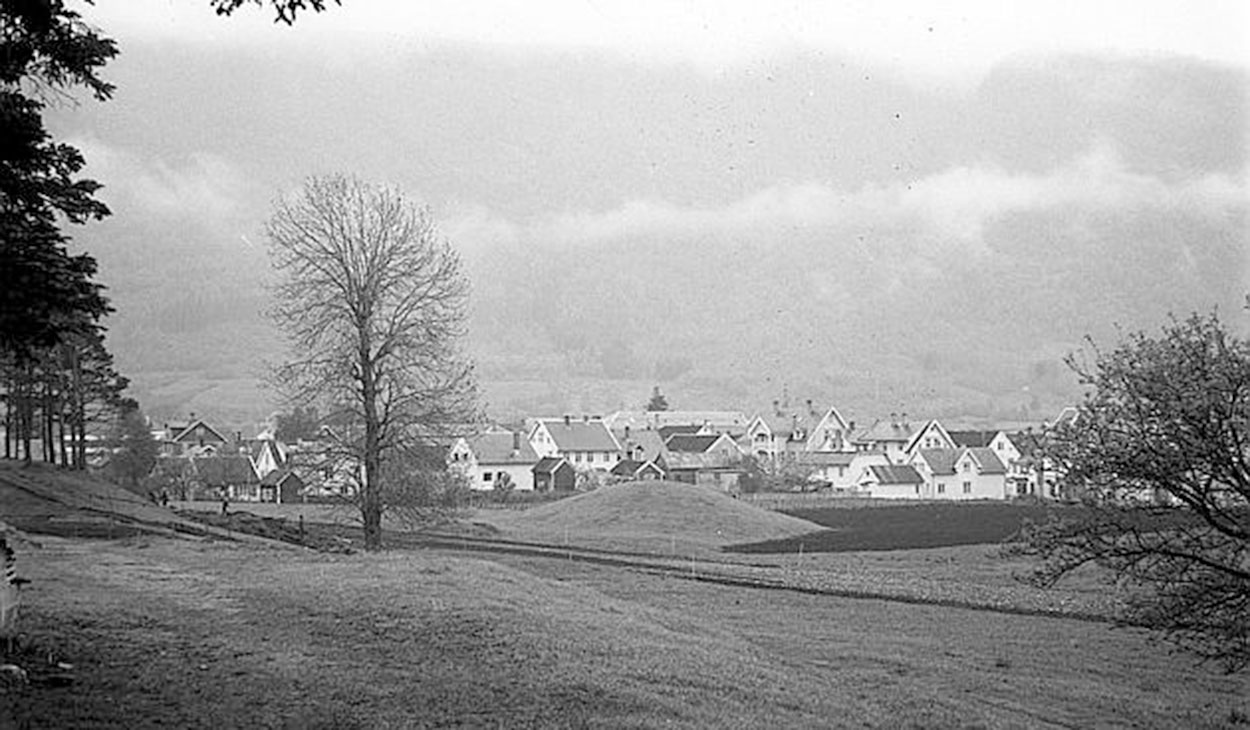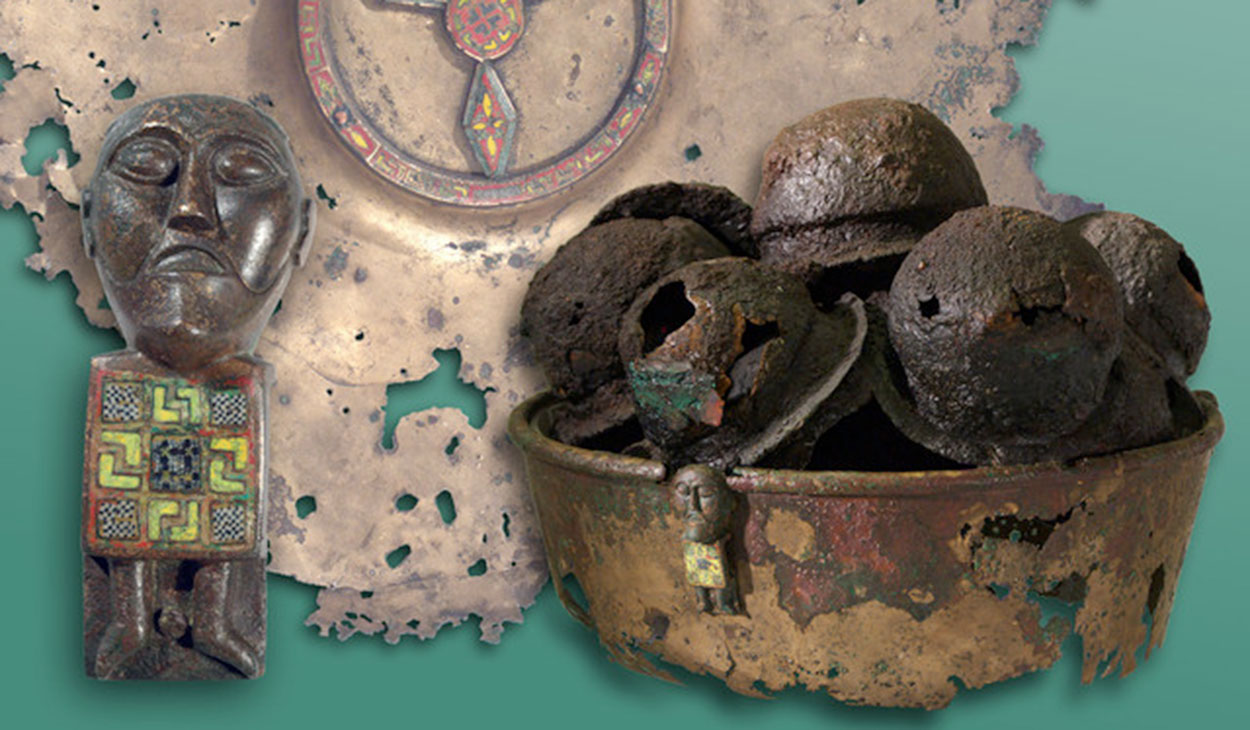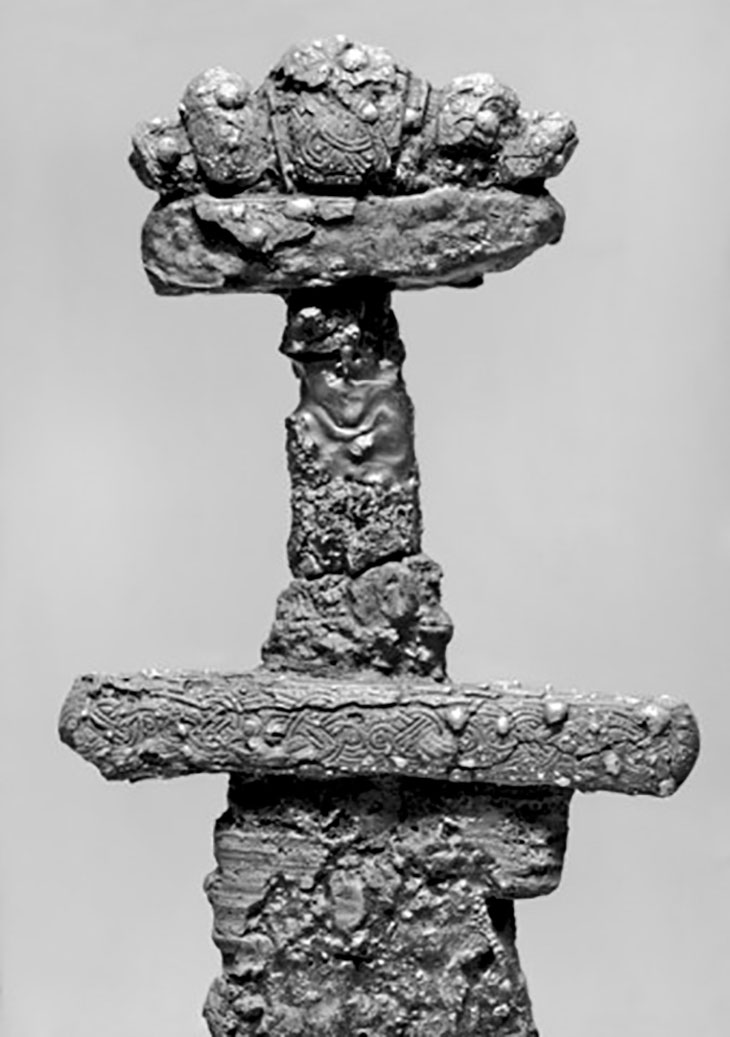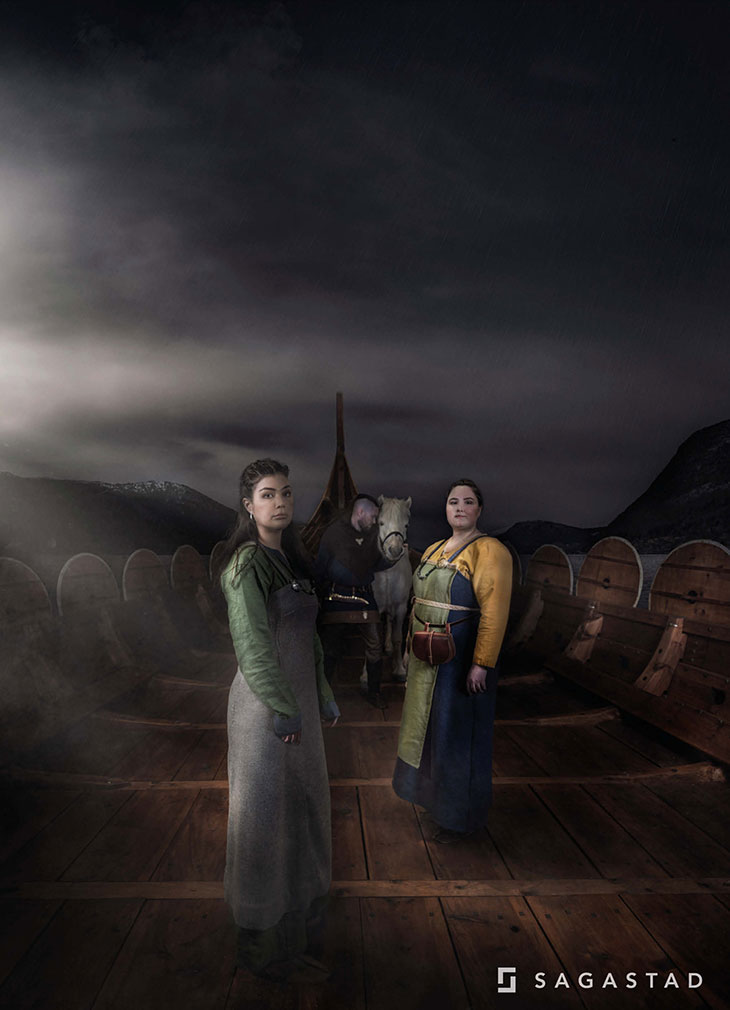The grave mounds
The grave mounds at Myklebust have been used for about 200 years. This means that during this period there may have been a center of power here in Nordfjordeid, possibly consisting of a ruling family. Being buried in a mound was a custom often reserved for rich and powerful people. Humans buried in the mounds at Myklebust were therefore probably important persons in the community.
The oldest tombs we have managed to date are from the last half of the eighth century and the youngest from the middle of the tenth century. It seems that before the Viking Age, there was no power centered on Nordfjordeid, but that this center of power arose at the beginning of the Viking Age. This power is legitimized in the burial mounds (monumental graves as a symbol of power), and power builds up throughout the period. At the end of the ninth century and towards the middle of the tenth century, we see an increase in grave mounds. This can be seen in connection with the social changes that took place during this period: the process of national unification and the Christianization of Norway. It is possible that the chief who ruled in Nordfjordeid would protect his power and territory, and that the increased number of graves is a witness to these stuggle.
Archaeological documentation from 1874 and 1902/03 shows that there have been five burial mounds on the Myklebust farm. They are documented as mound 1, 2, 3, 4 and 5.

Mound 1
Locally, we know this mound as “Rundehogjen” or “Lisje Skjoratippen”, and it was this mound that contained the remains of the Myklebust ship. The mound was excavated in 1874. This is early in the age of archaeology, when the main focus was to find the riches in the center of the grave, and the mound is not completely excavated. The finds must therefore be counted as a minimum of what the burial mound has contained.
The grave was a large cremation grave with urn. Around 750 rivets and nails were found in the fire flake. The burnt human bones were placed in an unburnt imported bronze vessel (the vessel is of Celtic origin, probably looted from an Irish monastery / church). Above the bronze vessel were 12 shield bosses that formed a protective lid. A total of 44 shield bosses were found, and it is likely that these represent the crew of the ship. The grave in this mound is dated to the last half of the ninth century.
Lost objects in the grave
There are probably many objects in the grave that have been lost in the cremation fire. We can never know what these things were or what they looked like, but we can think of many of the objects which probably were there, based on other findings from the period.
Textiles
The dead have probably been laid in the grave in their finest clothes, in addition there were probably carpets / tapestries and elaborate woven bands. Textiles were very important and valuable in Viking times and especially for the upper classes of society, expensive and elaborate colours and woven textiles were important to convey their wealth and status. The ship was a sailing vessel and the sail was probably also in the grave.
Horse equipment and animals
A bit from a horses bridle was found, and it is reasonable to assume that the horse or horses in the grave were equipped with saddles and harnesses at the time of the sacrifice. The saddle and harness are made of wood and leather and would not have survived the cremation. The same also applies to sword and knife sheaths, belts, etc. Archaeologist A. Lorange writes that there were a large amount of bone material in the layers of coal in the grave and by all accounts this is probably animal bone. Unfortunately, Lorange did not collect these bones, so we do not know what kind of animals were represented in the grave. One gets the impression that there were quite a lot of bones, and since they are clearly visible in the coal, they are probably larger animals. Among the bones were bones from horses, but from Oseberg and Gokstad as well as written sources, it is probable that in addition to horses there were both dogs and perhaps also cattle. We know that birds were common to sacrifice in connection with burials, but without collected material to analyse, it is impossible to know if this is the case here and in the case what type of bird. But both chickens and birds of prey such as falcons and owls are known in other contexts.
Wooden objects
In the Oseberg find, there were sledges and carriages, beds, chairs, wooden vessels and carved animal head figures. It is reasonable to assume that there are more wooden objects than the ship’s coffin in the Myklebust discovery. Wooden objects without iron fittings. It is probable that the deceased was laid in the ship in his bed, probably with bedding and pillow (s), and most likely that it has our containers such as wooden trays with food and drink among the grave goods. Food and drink were quite common for the journey to the realm of the dead, but are of course to a small extent preserved in the graves. It is reasonable to assume that any wooden objects in the find have been ornamented with carvings and colours. The dead and the grave goods were probably placed in a tent-shaped wooden burial chamber set up just in front of the mast of the ship.
List of findings
- Ship probably built of pine (massive layers of coal, about 700 rivets and nails, iron ring for the mast, fittings etc.)
- Horse (3?) Must have been at least one
- Animal bone unknown species
- Longbows
- Spear
- Shield bosses (44)
- Enamelled bronze vessel (Irish)
- Two swords
- Two Spears
- Axe
- Arrowheads (12)
- Knife
- Drilling tool
- Iron bar (unknown use)
- Horse bit (for bridle)
- Melted bronze (buckle?)
- Game pieces of bone (5)
- Dice of bone (3)
- Comb (2 pcs) of bone
- Glass bead of dark glass with white wave figures
- Hinges and hasps for chest / coffin
- Iron key for chest / coffin
- Various fittings for coffin
- Iron piece (travel cupboard?)
- Iron link
- Iron band
- Iron hook
- Iron ring
- Burned human bones (approx. 1.7 kg)
- Animal bones in goatskin (food for the journey)

Mound 2
Locally, we know this mound as “Skjoratippen”. This mound was excavated in 1902/03 by Håkon Shetelig. Thee were 5, maybe 6 graves in this mound. Two women’s graves, three men’s graves + an unknown, possible boat grave. The tombs date from the last half of the eighth century until the middle of the tenth century. This mound is a so-called dynasty tomb and shows that there has been a powerful family on the Myklebust farm over a long period of time. From the beginning, the mound may have been a mound that has grown for each new grave, or several mounds that have been closed and then combined into a bigger mound at the construction of the last grave.
A large number of objects from the various graves were found in this burial mound. It is the objects that have made it possible for us to date them typologically. This means that swords, jewellery and travel cabinets show a development from the older types that were found entirely in the beginning of the Viking Age (perhaps a little earlier, about the year 750), to the types that were found in the middle of the 10th century. What we actually see is e.g. an oval buckle from the oldest type that is small, almost completely smooth, only with a small pattern in the surface. The development of the oval buckle is clear when we come to the 10th century. The buckles then have double plates, knobs, animal ornamentation and strong relief.
The items in the mound were everything from swords, axes, shield bulges, kitchen utensils, jewellery and boat nails.
Mound 3
Was an oval shaped mound that was 27 m long, which stood on the same terrace edge as mound 2. This mound was removed without excavation, but before removal the archaeologist (H. Shetelig) had taken test pits and found unburned boat nails. There is therefore a possibility that this mound has at least one boat grave. The dating is unknown.


Mound 4
Located on the same terrace edge as mounds 2 and 3. During road construction in 1847, one edge of the mound was damaged and an unburned man’s grave was uncovered. Since the grave was so far out at the edge, it was thought that this could not be the primary grave, and surely when the rest of the mound was completely examined in 1902/03, they found a woman’s grave in the form of a fire flake (cremation grave) near the middle of the mound. A large number of rivets indicate that the woman was burned in a boat. Both tombs are dated to the 10th century.
- Objects from the man’s grave: a sword and a spearhead
- Objects from the woman’s grave: 350 rivets, an oval bronze buckle and other jewellery, a glass bead, kitchen utensils, textile tools, animal bones and a special staff.
- The women’s grave has been interpreted as being a so-called Volve grave. A volve is a witch, perhaps a ritual leader. Volve means «rod bearer».
Mound 5
We lack complete information about this mound, as it was removed in 1875 without excavation. The objects that had been found during the removal had been taken care of, which still give us clues: Two swords, two axe blades, two drills, an anvil, a hammer, blacksmith pliers and one saw blade had been found. The objects showed traces of being on fire. Despite the lack of discovery context, it is possible that mound 5 may have contained two men’s graves.

The King in Mound 1
The large ship grave has been discussed to have an connection to Audbjørn, the King of the Fjords, which is mentioned in Snorre’s saga about Harald Fairhair. It says that King Audbjørn was the king of the Firda county and travelled up to the island of Solskjel in 876 to fight against Harald Fairhair. King Audbjørn died there. What one has believed is that Audbjørn had his seat on Myklebust here on Nordfjordeid and was burned with his ship and buried in the mound on the beach at Myklebust. It is always problematic to have to use the saga material to “prove” something – this also applies here. We cannot say for sure that the man in the grave is King Audbjørn. But we can say that it is possible, because it is possible. Several facts support this claim:
The tomb is dated to the latter half of the ninth century. Typologically dated however, not an absolute dating.
The human bones in the grave have been analysed: they come from a well-built man who died when he was between 30 and 35 years old.
The legs showed traces of cuts and stab wounds. These are injuries that would be matched with war injuries.
Between the bones was a single arrowhead. It is probable that this was inside the man’s body when he was burned, and that this was a result of the war.
The grave itself, and the ship that came with it, undoubtedly refers to a man of special importance. It is a tomb worthy of a chieftain or a king.
Whether it was Audbjørn or not, the burial ground at Myklebust shows an exciting story. The man buried here was probably an important figure of his time. But the Viking Age mounds disappear towards the latter half of the 10th century. Did the people become Christian? Did the center of power die out? Did they move? Or did they only change burial customs?